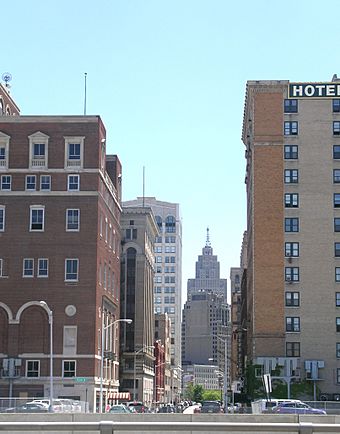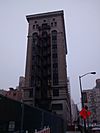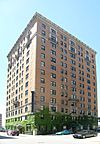Park Avenue Historic District (Detroit, Michigan) facts for kids
|
Park Avenue Historic District
|
|

Park Avenue Historic District, looking south from across I-75
|
|
| Location | Detroit, Michigan, U.S. |
|---|---|
| Architectural style | Early Commercial, Late Victorian |
| NRHP reference No. | 97000396 |
Quick facts for kids Significant dates |
|
| Added to NRHP | May 13, 1997 |
The Park Avenue Historic District is a special area in Detroit, Michigan. It's a collection of important buildings along Park Avenue, between Adams Street and I-75.
This district includes famous places like the Detroit Women's City Club, the Detroit Building, and the Park Avenue House. Because of its history and unique buildings, it was named a Michigan State Historic Site in 1996. Then, in 1997, it was added to the National Register of Historic Places. This means it's recognized as a very important historical place in the United States.
Contents
History of Park Avenue
In the 1920s, Detroit was growing fast because of the car industry. The area around Grand Circus Park was getting very crowded. Businesses needed more office space. So, new buildings started to appear north of Grand Circus Park, along Park Avenue.
In 1922, a famous architect named Albert Kahn designed the Park Avenue Building. This building was at the start of Park Avenue. Other architects also helped design hotels, apartments, and offices in the area.
A Planned Community
In 1923, a group called the Park Avenue Association was created. They had a plan for the street. They wanted fancy offices and shops at the south end. The north end would have nice homes and apartments. People in Detroit thought of Park Avenue as their city's version of New York City's famous Fifth Avenue.
Park Avenue was also home to important women's groups. These included the Detroit Women's City Club and the Detroit chapter of the Colony Club. These clubs helped women with social events and work activities. They also supported women's rights, like the right to vote.
Changes Over Time
The area was not used as much during the Great Depression in the 1930s. But after World War II, it became busy again. Many different social groups used the area. New restaurants and entertainment places opened up.
Around this time, the Iodent Chemical Company started making toothpaste in a building on Park Avenue. This added a new kind of business to the district.
In the 2000s, the area saw a lot of new development. This was partly because of nearby entertainment spots. The Fox Theatre and Comerica Park are very close. The old Iodent Building was turned into modern apartments called lofts. The Colony Club was also fixed up. Two new entertainment places, Cliff Bell's and the Park Bar, also opened.
The district was officially listed as a state historic place in 1996. It was then added to the National Register of Historic Places in 1997.
Historic Buildings of Park Avenue
The Park Avenue Historic District has thirteen important buildings. Two of these, the Detroit Women's City Club and the Park Avenue House, are so special they are listed separately on the National Register.
Two other buildings, the Park Avenue Building and the Kales Building, are very close. But they are part of the Grand Circus Park Historic District, so they are not in this district.
Here are some of the main buildings in the Park Avenue Historic District:
| Name | Image | Year Built | Location | Style | Architect | Notes |
|---|---|---|---|---|---|---|
| Women's City Club |  |
1922 | 2110 Park Avenue | William B. Stratton; Waldridge & Aldinger | This building is listed on the National Register of Historic Places. | |
| Detroit Building |  |
1923 | 2210 Park Avenue | Beaux-Arts | Arnold & Shreve | It was updated in 2009. It is also listed on the National Register of Historic Places. |
| Park Avenue House |  |
1924 | 2305 Park Avenue | Louis Kamper | The Town Pump Tavern is on the first floor of this tall residential building. It is listed on the National Register of Historic Places. |
See also
 In Spanish: Distrito histórico de Park Avenue (Detroit) para niños
In Spanish: Distrito histórico de Park Avenue (Detroit) para niños

